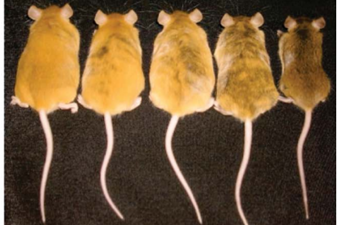
Note: Image adapted from Dolinoy, Weidman, Waterland & Jirtle 2006 in Enviromental Health Perspectives [2].
The human body consists of more than 200 different types of cells, but all cells contain the same DNA code. How is it possible that the same code tells the various types of cells to be different? The information for life is not only coded in the DNA, but also on the DNA. Chemical attachments, which are called DNA methylation, can “turn off” part of the DNA code that are not needed in a specific cell. DNA methylation can also be influenced by our surroundings [1].
Fifteen years ago, researchers performed a very important experiment to show that diet is part of the surrounding modifiers of DNA methylation [2]. They used a mouse model, which has a range of different fur colors: from yellow to brown (see figure). The DNA code for the fur color is regulated by DNA methylation. The browner the color of the mouse, the more DNA methylation is present at the fur color DNA code.
The researchers gave pregnant mice either their standard diet, or a special diet. This special diet contained nutritional factors, which are needed for DNA methylation. When the female mice gave birth, it became clear that the special diet increased the DNA methylation at the fur color DNA code in the pups. These pups also had more often a brown fur color than the pups from the mothers with the standard diet [3].
When you have a close look at the figure, you see that the yellow mice are also fatter than the brown mice. The diet of the mother during pregnancy did not only change the fur color of her offspring, but also their physical health!
So our surroundings, and even our surroundings before we are born, are very important in shaping our DNA methylation. And DNA methylation, in turn, can shape our health. This is not only the case for physical health, but also for our mental health. That is why the researchers of Eat2BeNice are investigating this interplay between our DNA and our surroundings through DNA methylation and other DNA modifications. We hope this will give us a better understanding of mental health and how our surroundings contribute to mental health!
Further Reading
[1] Do you want to read more about DNA methylation and how we study this in ADHD? Check this article, that I wrote with some other members of the E2BN consortium.
Switching Genes On and Off: How It Can Shape Us · Frontiers for Young Minds (frontiersin.org)
